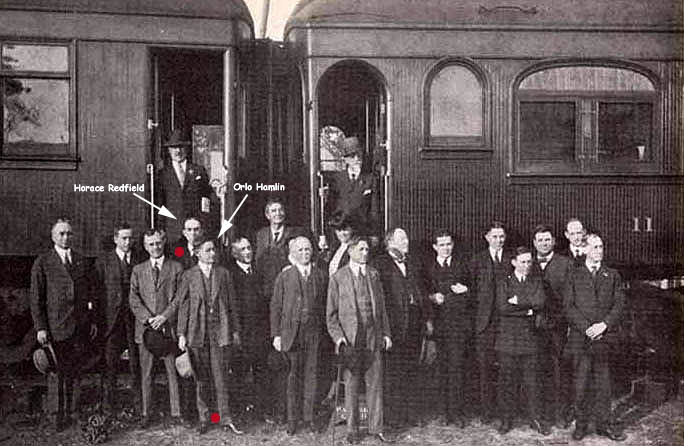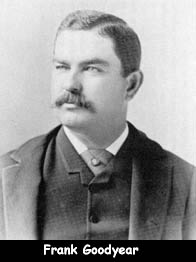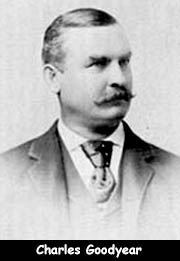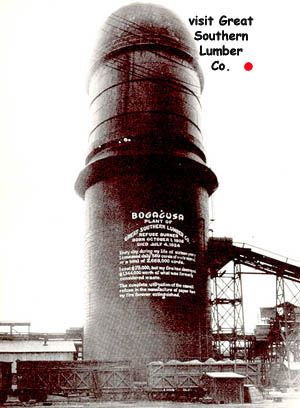Perpetual
Timber Job of Local Capitalists Attracts Attention
McKean County Democrat; April 17, 1930
The Last issue of the National Geographic Magazine
devotes much to an interesting feature article on Louisiana by Ralph
Graves, which describes in detail the vast lumbering operations
of the Great Southern Lumber company at Bogalusa, La.
The subject is of great local interest due to
the fact that the vast Bogalusa project is the result of the foresight
of the late Byron D. and Henry Hamlin of Smethport who purchased
the huge Louisiana forest acreage before the Civil War, and who,
with the Goodyears of Buffalo, in later years started the Bogalusa
development.
H.
H. Redfield and O.
J. Hamlin of Smethport are prominent executives of the Great
Southern Lumber Co. and of the New Orleans and Great Northern railroad,
and many Smethport people own stock in the two companies.
The National Geographic Magazine article describes
progress of the great reforestation program being carried on by
the Great Southern Lumber Co., the start of which was described
by the Democrat several years ago on information given this newspaper
by H. H. Redfield, director of the company.
As stated in the Democrat at that time, the
reforestation program is destined to make the Bogalusa operations
perpetual by scientific planting of young trees in the wake of the
timber cutting operations.
The plan has been closely copied after the program
followed at a great lumbering operation in Norway where one company
has continuously operated on one great timber tract for several
centries.
Charles Goodyear of Buffalo, an officer of the
Great Southern Lumber Company, spent considerable time in Norway
making a thorough study of the Norwegian company's interesting reforestation
achievement.
The company established a great tree nursery
at Bogalusa in 1927 and during 1928-29 slash pine seedlings to the
number of 6,000,000 were set out on 7000 acres of cut-over forest
land. Trees are planted 900 to the acre.
The reforestation plan provides for lanes at
studied intervals for forest fire prevention, also to be used for
hauling away turpentine.
The record of growth of the slash pine seedlings
indicates that they will be ready for pulpwood in from 15 to 20
years and will be full-grown trees, ready to yield lumber in 40
years. The long-leaf pine variety will take from 10 to 20 years
longer to mature.
The Great Southern Lumber Co. mill at Bogalusa
shares with a similar one in the State of Washington the distinction
of being one of the world's two largest sawmills. It has a capacity
of three-quarters of a million feet of sawed lumber each day.
Ordinarily the company's mill would have exhausted
the vast timber tract by 1940, but to keep the mill going and at
the same time allow the reforestation program to catch up with sawing
operations to make the project perpetual, the company operates a
fleet of five steamships which bring squared redwood logs from California,
via the Panama Canal, to be sawed at the Bogalusa mill.
The Bogalusa timber tract of the Great Southern
Lumber Co. consists of half a million acres - nearly as large as
the surface of the state of Rhode Island.
In addition to the huge sawmill, the company
operates a pulp mill which utilizes all refuse to manufacture kraft
wrapping paper. Other waste is consumed as boiler fuel.
The National Geographic article was accompanied
by several illustrations of the Bogalusa plant, one of the reforestation
plantings, one of the pulp mill and one of the great refuse burner
which has not been used since 1924.
On the side of the huge burner, left standing
as a monument to wasteful methods is painted the following:
"Bogalusa Plant of the Great Southern Lumber
CO. Refuse Burner. Born Oct. 1, 1908. Died July 4, 1924. Every day
during my life of sixteen years I consumed daily 560 cords of waste
materials or a total of 2,688,00 cords. I cost $75,000 but my fire
has destroyed $1,344,000 worth of what was formerly considered waste.
The complete utilization of the sawmill refuse in the manufacture
of paper has my fire forever extinguished."
Conservation is the watch-word of the Great
Southern Lumber Co. | 

 Frank
and Charles Goodyear met Will Sullivan on the train going to one of their
many Pennsylvanian sawmills and gave him a job. Sullivan moved to Austin
with his wife not to far from the sawmill. Soon Sulivan talked the Goodyears
into moving towards contracting the logging of lumber, which was a big
financial step. Both of the Goodyear brothers were into their fifties
when they made this huge investment to buy lumbering land down south.
Its was Frank, though, that had the ambition to make things bigger. He
and his wife, Ella Goodyear, often attended fancy parties with the President
Grover Cleveland. They lived in Bogalusa except for one month a year,
which was spent in Pennsylvania and New York. All together they put about
fifteen million dollars into buying the land and building what was needed
for a booming town.
Frank
and Charles Goodyear met Will Sullivan on the train going to one of their
many Pennsylvanian sawmills and gave him a job. Sullivan moved to Austin
with his wife not to far from the sawmill. Soon Sulivan talked the Goodyears
into moving towards contracting the logging of lumber, which was a big
financial step. Both of the Goodyear brothers were into their fifties
when they made this huge investment to buy lumbering land down south.
Its was Frank, though, that had the ambition to make things bigger. He
and his wife, Ella Goodyear, often attended fancy parties with the President
Grover Cleveland. They lived in Bogalusa except for one month a year,
which was spent in Pennsylvania and New York. All together they put about
fifteen million dollars into buying the land and building what was needed
for a booming town. 